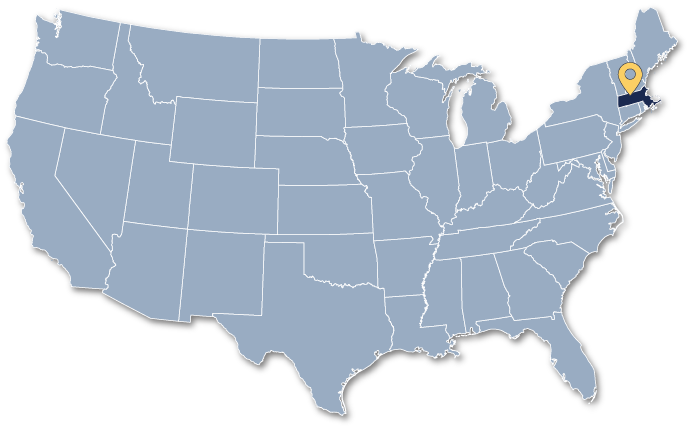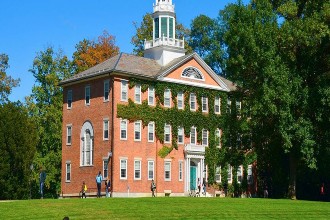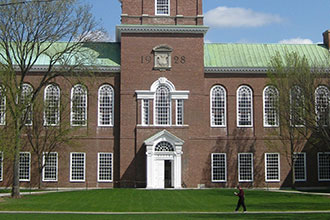Amherst College
REQUIREMENTS AND CAMPUS GUIDE
School Name: Amherst College
School Location: Amherst, MA
School Type: Private Liberal Arts
Category: High Reach
Amherst College Admissions Rates
Based on Class of 2026
Applications: 14,800
Admitted: 7%

General Info
SAT/ACT Score
Test Optional for 2022-2023
Admission Cycle
Fall 2021 Test Scores
Math: 720-790
ERW: 720-780
ACT: 32-35
Dates/Deadlines
Early Decision: November 1
Early Results: Early-to-mid December
Regular Deadline: January 3
Regular Results: Late March
School Information
Schedule: Semesters
7:1 Faculty Ratio
Curriculum Type: Open Curriculum
Greek Life: No
Athletics: DIII
AHMHERST TIPS & GUIDE
Amherst Application Requirements, Admissions Tips, and University Guide
Amherst College is one of the most selective and academically rigorous liberal arts colleges in the U.S.. With a total enrollment of under 1,900 students, the college’s small size ensures that students have an intimate academic experience and build close relationships with each other and with faculty. Its membership in the Five College Consortium, however, also enables students to pursue an expanded range of course options and a broader social life. Here’s everything you need to know about Amherst!
How diverse is Amherst?
In the class of 2026, 62% of students admitted to Amherst College identify as domestic students of color. The students come from 50 different countries, including 48 U.S. states plus Washington D.C., Puerto Rico, American Samoa and the U.S. Virgin Islands. 9% of admitted students are international students, and 22% are first generation college students.
What is Amherst’s acceptance rate?
14,800 students applied for the class of 2026, and Amherst accepted 7% of those students.
The college plans to enroll 473 students in the Class of 2026.
What is Amherst known for?
Amherst is known as “The Writing College” thanks to its many alumni who went on to become award-winning novelists, poets, journalists and critics. They are also responsible for producing world-renowned literary publications. The college is home to thousands of Emily Dickinson’s manuscripts, letters and personal objects, showcasing their love of literature. Additionally, Amherst has one of the largest theater collections in the world and administers the Folger Shakespeare Library.
Can I afford Amherst?
Like other private colleges, at first glance Amherst appears outlandishly expensive. The school’s comprehensive fee for 2022-2023, which consists of tuition, room, and board, is $80,250. Amherst estimates the actual cost of attendance to be $ 86,459 – $ 88,909 depending on how far you have to travel to school, how much you spend on books, etc. Fortunately, last year 60% of Amherst students received scholarship aid from the college. Financial aid is also available to non-US citizens and transfer students. If you want a better idea of what tuition would cost you before you go through the application process, you can calculate what you’ll need to pay on their website. Keep in mind that need (as opposed to merit) is the only criterion for receiving financial aid from Amherst, and the college’s goal is to meet your “full demonstrated need” so that there’s no gap in their financial aid awards. Parent PLUS loans and monthly payment plans are available to those who don’t receive as generous of a financial aid package, but also can’t afford to pay the entire tuition at the beginning of each year.
What is the Open Curriculum?
Unlike many liberal arts colleges, Amherst doesn’t have any general education requirements. Instead, they have an “open curriculum” with no distribution requirements and no core curriculum. That gives you the freedom to take a wide variety of courses in any subjects that interest you. Additionally, the open curriculum system makes it easier to double major (40% of Amherst students double-major, and triple-majors are rare but possible) and still have enough time to explore other disciplines, because you aren’t busy fulfilling requirements in fields that don’t interest you. Students are also able to cross-register for courses at any of the institutions in the Five College Consortium, which includes Hampshire College, Mount Holyoke College, Smith College, and the University of Massachusetts Amherst.
How is the campus life at Amherst?
Housing: Almost all Amherst students live on campus, and the college guarantees housing for students all four years. As a first-year student, you will live in a dorm in the first-year quad, located in the heart of campus. There are 34 residence halls total, seven of which are reserved for first-year students. Living in such close quarters with your classmates makes it easier to make lasting friendships early on in your college experience. After you’ve bonded with new friends, you can choose your favorite dorm to live in for sophomore, junior, and senior year.
Food: Students eat in Valentine Dining Hall, which accommodates most dietary needs with locally-sourced food. Amherst has its own farm, Book & Plow Farm.
Does Amherst have any STEM programs?
Even though Amherst is a liberal arts college most known for its humanities departments, students interested in STEM can also find a home here. Amherst boasts of a faculty that researches “topics ranging from the quantum behavior of molecular nanomagnets, to brain circuitry, to fish evolution, to disease transmission and genomics.” Indeed, you might have even more opportunities to shine in a STEM major at Amherst, because many students are listed as co-authors of scientific articles and/or present their findings at national conferences. Plus, you get to work directly with faculty—rather than with grad students or PIs— on research projects. In recent years, Amherst has also invested into expanding its STEM facilities and resources. At the Bassett Planetarium, Wilder Observatory, and a newly constructed Science Center, students can take classes, conduct research, and utilize makerspaces for coursework or personal projects.
Compared to offerings at a larger research university, some of Amherst’s STEM courses and extracurricular programs may be more oriented towards humanistic, ethical, and sociological concerns. The Being Human in Stem (HSTEM) Initiative is only offered by Amherst and Yale, and aims to foster a more inclusive STEM community. Its goal is to understand and incorporate diverse identities in scientific spaces from the classroom to the lab and beyond. A new Incubator program was also launched in 2020 to support students who are traditionally underrepresented in STEM, including Black, Latinx, Indigenous, first-generation and low-income students. For students interested in intensive mentorship and/or intersections between STEM and the humanities, Amherst may be a good fit.
Do I have to submit supplemental materials with my application?
When you apply to Amherst either through the Common Application or the QuestBridge Application, you will have an option to submit supplemental materials. There is one mandatory supplement, the Amherst Writing Supplement, which is either a 300 word paper, or a previously graded assignment from your junior or senior year of high school. You can also submit optional supplemental pieces.
If you have any special talents or accomplishments related to the arts, you can submit relevant material through the Application Status Portal (ASP), a secure online site personalized for each Amherst applicant. If you’ve participated in significant research in any field (natural sciences, mathematics, computer science, social sciences or humanities) independently of your high school curriculum, you can include a brief description of your progress in the “Optional Research Questions” section of Amherst’s Writing Supplement.
What is the city of Amherst like?
Amherst is a vibrant small town with many amenities, beautiful natural surroundings, and a diverse community that is home to 30,000 college students during the academic year. Additionally, 40% of the local population has a graduate degree. In addition to regular events at each of the nearby colleges, you can find things to do on campus as well. There are hiking trails, fishing streams, and boating on the Connecticut River. Amherst itself has community centers and affinity spaces, its own student nightclub, and a 500-acre wildlife sanctuary to which you can escape when the libraries and classrooms become too claustrophobic. Getting to (or out of) Amherst couldn’t be easier; Bradley International Airport near Hartford, Conn., is about an hour from campus, and Boston’s Logan Airport is about two and a half hours away. Amherst provides shuttle transportation from either airport to campus.
Ahmherst Admission Rates
| | Data Source | Admission Rate |
|---|---|---|
| Class of 2025 | CDS 2021-2022 | 8.74% |
| Class of 2024 | CDS 2020-2021 | 11.80% |
| Class of 2023 | CDS 2019-2020 | 11.30% |
| Class of 2022 | CDS 2018-2019 | 12.80% |
| Class of 2021 | CDS 2017-2018 | 12.90% |
MORE SCHOOLS TO CONSIDER

Williams College
School Location: Williamstown, MA
School Type: Liberal Arts

Dartmouth College
School Location: Hanover, NH
School Type: Liberal Arts / Ivy League

Claremont McKenna College
School Location: Claremont, CA
School Type: Liberal Arts
View All Schools ↓
| American Univ Amherst Brown Boston Univ CalTech Carnegie Melon Claremont McKenna Columbia Cornell Dartmouth Duke Emory Georgetown Georgia Tech Harvard Hopkins |
MIT NYU Northeastern Northwestern Notre Dame Princeton Rice Stanford Tufts Tulane UChicago UC Berkeley UC Davis UCLA |
UCSB UCSD UIUC UMich UNC UPenn Univ of Southern California UT Austin UVA Vanderbilt Villanova WashU Williams Wisconsin Yale |
*Updated 2022

